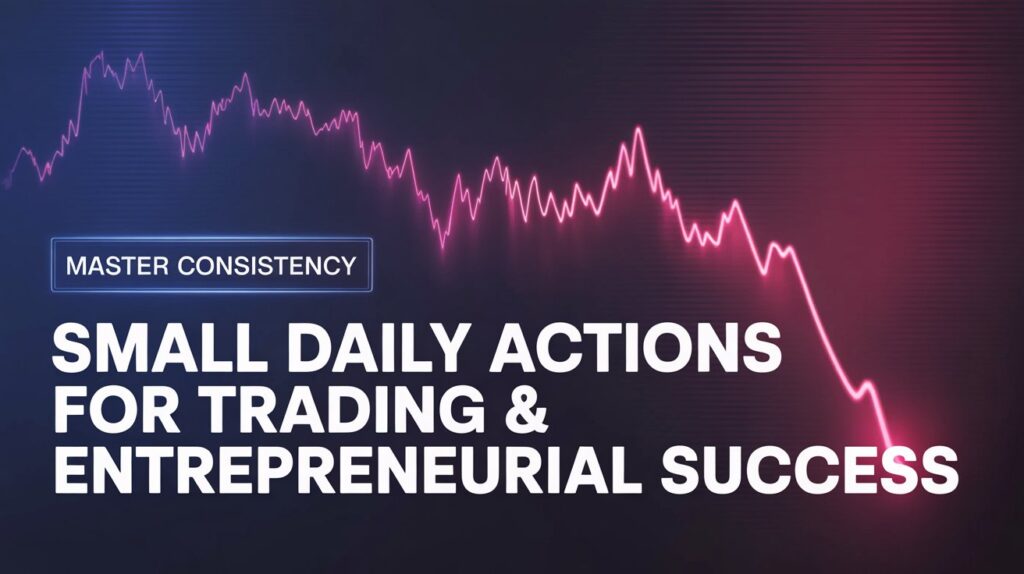Most people think pressure is the enemy.
But here’s the truth, diamonds don’t form in comfort.
They’re born deep underground under heat and pressure that would crush almost anything else.
So are great entrepreneurs. So are elite athletes.
So are resilient traders.
And so are you.
The question isn’t “Will I face pressure?”
You will. Everyone does.
The real question is:
When it comes, will it shape you or shatter you?
That’s what a growth mindset is about, understanding that pressure isn’t here to destroy you.
It’s here to develop you.
This article breaks down how pressure can shape your growth instead of destroying it. You’ll learn the science behind stress, how a growth mindset rewires your response under pressure, and the exact mental tools to turn challenge into strength. Whether you’re a trader, entrepreneur, or anyone navigating high-stakes performance, this will show you how to thrive when it matters most.
Reframing Pressure: The Shift That Changes Everything
Pressure feels personal, doesn’t it?
Your heart races, your palms sweat, your thoughts spiral.
And suddenly, you’re convinced that something’s wrong with you.
But here’s the thing: pressure isn’t punishment. It’s information.
Pressure as a Signal, Not a Sentence
When I started trading, every losing streak felt like a personal failure.
I’d tell myself, “I’m not good enough. Maybe I’m not built for this.”
But over time, I learned something powerful, pressure is a signal.
It tells you something matters.
It tells you you’re stretching, learning, leaving the safety of your comfort zone, the only place where real growth happens.
So the next time pressure hits, instead of thinking, “Why is this happening to me?”
Try asking, “What is this trying to teach me?”
That one reframe changes everything.
The Challenge Response vs. The Threat Response
Stanford psychologist Kelly McGonigal talks about two ways we respond to stress.
One is the threat response, where stress feels overwhelming and you shut down.
The other is the challenge response, where stress sharpens you, wakes you up, and helps you rise to the occasion.
The difference between the two?
Your mindset.
People with a fixed mindset see pressure as proof they’re not enough.
People with a growth mindset see it as an opportunity to become more.
The pressure doesn’t change.
But you do.
Fixed vs. Growth Mindset Under Pressure
| Aspect | Fixed Mindset | Growth Mindset |
| Response to Stress | Avoids pressure | Uses pressure to grow |
| View of Failure | Proof of weakness | Lesson for improvement |
| Focus | Outcome and judgment | Process and effort |
| Motivation | Fear driven | Purpose driven |
| Result | Burnout and stagnation | Resilience and mastery |
Building Stress Optimism
If you believe stress is harmful, it will be.
Your body will react as if you’re under threat.
But if you believe stress can help, that it’s your body preparing you for performance, your physiology changes.
That’s what Harvard researchers found in this study: people who reinterpreted stress as useful performed better and felt calmer.
A growth mindset fuels that belief.
It says: “This isn’t pressure. This is potential in disguise.”
The Diamond: Forming Power of Pressure
Pressure doesn’t just test you, it builds you.
And I’m not saying that from theory.
I’ve lived it.
When I was paralyzed from the neck down, I had every reason to give up.
But what looked like the end became the forge.
Pain became purpose.
That’s what pressure does when you meet it with the right mindset.
“You can’t master calm without walking through the storm.”
Post-Traumatic Growth: Turning Adversity into Strength
Everyone knows PTSD (Post-Traumatic Stress Disorder).
But few know about PTG, Post-Traumatic Growth, the process where people come out of adversity stronger, not weaker.
They report deeper gratitude for life.
Stronger connections.
Clearer purpose.
It’s not that the trauma was good.
It’s that they grew through it.
And that’s the key difference.
People who grow through pain don’t “move on.”
They move forward.
A recent American Psychological Association (APA) report confirms that individuals who actively practice mindset reframing and stress inoculation training show a 32% higher resilience index compared to those who suppress or avoid stress. This reinforces that pressure, when channeled consciously, fuels post-traumatic growth and long-term emotional stability.
Micro-Pressures Build Macro Strength
Growth isn’t built only in tragedy.
It happens in your daily reps, the moments you don’t quit.
Just like in the gym: you lift a little heavier, you feel resistance, you grow.
In trading, every losing trade is a rep for emotional strength.
In business, every rejection trains your endurance.
In recovery, every small movement rebuilds your belief.
A growth mindset sees every challenge as a rep.
Every rep makes you tougher, calmer, more capable.
Failure Isn’t a Wall, It’s the Way
No diamond forms without heat.
No growth happens without failure.
A fixed mindset says, “I failed, so I must not be enough.”
A growth mindset says, “I failed, so now I know what doesn’t work.”
Failure isn’t your identity. It’s your instructor.
And if you listen, it’ll teach you more than success ever will.
Also Read this: The Breakthrough Science of a Positive Mindset for Peak Performance
When Pressure Breaks You and Why
Let’s be real. Pressure can break people.
But not because it’s too heavy, because they never learned how to carry it.
The Fixed Mindset Trap
A fixed mindset avoids pressure.
It says, “If I were talented, this would be easy.”
So it hides from discomfort, avoids risk, and fears challenge.
But growth doesn’t happen where you feel safe.
It happens where you feel stretched.
Pressure avoided becomes potential wasted.
The Spiral of Self-Doubt
When you don’t trust yourself under pressure, the mind starts whispering:
“What if I mess up?”
“What will people think?”
“Maybe I’m not cut out for this.”
That spiral leads to anxiety, perfectionism, and paralysis.
Performance doesn’t break from incompetence, it breaks from insecurity.
Perfectionism: Pressure Turned Toxic
Perfectionism is pressure’s dark side.
It whispers that “only perfect is good enough.”
But perfection is a moving target, one you’ll never hit.
A growth mindset replaces perfect with progress.
It knows that done beats perfect, and better beats best.
How to Cultivate a Growth Mindset Under Pressure
Here’s how I train myself, and how you can too, to stay calm and clear when life turns up the heat.
Reframe the Pressure
Start with awareness.
When you feel that knot in your chest, name it.
Say, “I feel pressure because I care.”
That alone shifts your body from fight-or-flight to focus.
Then zoom out. Ask yourself:
“Will this matter in five years?”
Most pressure is temporary. Growth isn’t.
And remember, pressure isn’t personal.
It’s part of the process.
Practice Self-Compassion
You don’t grow by beating yourself up.
You grow by supporting yourself through the fall.
Talk to yourself like a coach, not a critic.
“This is tough, but I can learn.”
“I’ve been here before.”
“Every master was once a beginner.”
Self-compassion isn’t weakness.
It’s the foundation of resilience.
Focus on Effort, Not Outcome
You can’t always control the outcome.
But you can always control your effort.
Ask:
- Did I prepare?
- Did I stay disciplined?
- Did I improve, even slightly?
If yes, you’re winning.
Celebrate the Small Wins
Every time you do something that scares you, celebrate it.
Every time you get up after failing, celebrate it.
Those moments are your real breakthroughs.
Progress compounds quietly.
That’s how diamonds form slowly, consistently, under steady pressure.
5. Train for Pressure: Don’t Avoid It
Build what psychologists call stress inoculation.
Expose yourself to small doses of stress, recover, and repeat.
You can do it in the gym, in simulations, in mock trades, or presentations.
Each exposure builds your threshold.
As studies show, this kind of deliberate pressure training reduces anxiety and improves real-world performance.
The more you practice discomfort, the less it controls you.
Read this: The Breakthrough Science of a Positive Mindset for Peak Performance
Beyond Resilience: Thriving Under Pressure
Resilience is about bouncing back.
Thriving is about bouncing forward.
A growth mindset doesn’t just help you survive.
It helps you evolve.
You don’t return to who you were, you become someone new.
Finding Purpose in Pressure
Pressure without purpose feels like punishment.
Pressure with purpose feels like progress.
Psychiatrist Kazimierz Dąbrowski once said:
“Mental health is not a lack of conflict, but the ability to deal with it creatively.”
That’s what purpose gives you, meaning in the chaos.
When a trader studies late because they want freedom.
When a founder stays up because they believe in their product.
When a survivor fights through pain because they refuse to quit.
Purpose doesn’t remove pressure.
It makes it worth it.
Key Takeaways
- Pressure isn’t your enemy, it’s your teacher.
- A growth mindset sees pressure as feedback, not failure.
- Micro-pressure builds macro strength.
- Failure is instruction, not identity.
- Self-compassion, effort, and perspective keep you grounded when life tests you.
- Don’t just be resilient, be reborn through pressure.
Conclusion: Pressure Is the Price of Purpose
You can’t grow without stress.
You can’t lead without weight.
You can’t shine without pressure.
Diamonds aren’t made in quiet conditions.
Neither are exceptional people.
Pressure isn’t here to break you.
It’s here to build you.
So when life tightens its grip, don’t ask, “Why is this happening to me?”
Ask, “What is this trying to build in me?”
Because with the right mindset, pressure doesn’t just create success.
FAQs
1. How does a growth mindset help in dealing with pressure?
A growth mindset helps individuals see pressure as a challenge rather than a threat. It encourages learning from setbacks, adapting to stress, and using pressure as a tool for personal development instead of something to avoid or fear.
2. What is the difference between a growth mindset and a fixed mindset under pressure?
A growth mindset views pressure as an opportunity to grow and improve, while a fixed mindset sees it as a threat to self-worth. This difference often determines whether someone thrives or breaks under high-stress situations.
3. Can pressure actually lead to personal growth and success?
Yes. When approached with a growth mindset, pressure can lead to skill development, resilience, and even post-traumatic growth. It’s not the pressure itself, but how you respond to it, that shapes your potential.
Can stress really make you stronger?
Yes. Studies from Stanford University show that when people view stress as a helpful signal, their focus and performance improve significantly.
What is a growth mindset under stress?
It’s the belief that stress and pressure are opportunities for learning, not signs of weakness. You grow stronger by engaging with the challenge rather than avoiding it.




